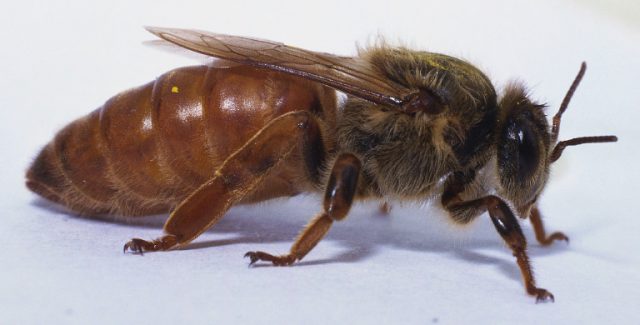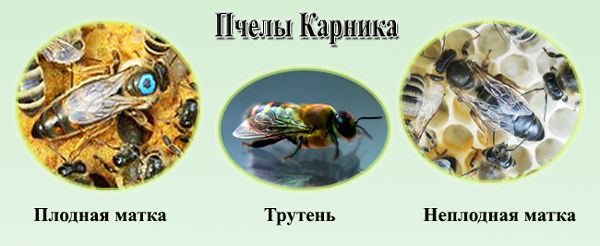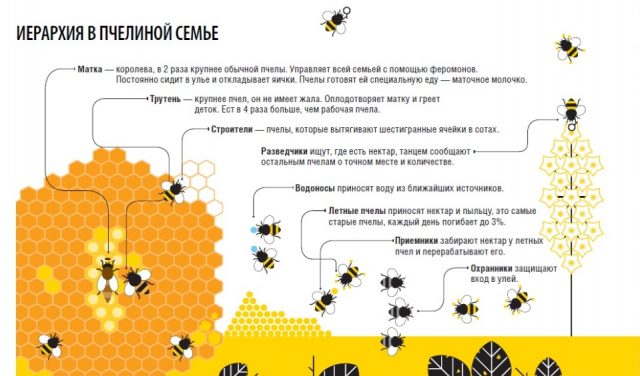Content
Bees are an organized species of creatures that live according to their own established laws and rules. Over millions of years of evolution, the formation of a social type of behavior, the division of individuals according to functions, was carried out. Each bee has a purpose and it does not matter at all whether it is a drone, a worker or a queen bee, thanks to which the bee community achieves normal life. The queen bee is the queen of the hive, who not only unites the whole family, but also continues the family. The main task of the queen bee is reproduction and keeping the family intact.
What does a queen bee look like?
A distinctive feature of the queen bee is its size. As a rule, the queen bee is several times larger in length and weight. The body length is 2-2.5 cm, and the weight ranges from 18 to 33 g.
The body of the queen is elongated, the abdomen has a torpedo shape, which protrudes quite strongly beyond the wings. Unlike other insects, the queen bee's eyes are much smaller, there are no differences in the internal structure. The main difference between the queen bee is the developed ovaries.
The queen bee is slow, it is difficult for her to move, as a result of which she does not leave the hive without the need for mating, or swarming... The queen is constantly surrounded by worker bees who take care of and feed the hostess. If necessary, you can see what the queen bee looks like in the photo.
Fetal uterus
As a rule, a fetal queen is a queen bee who managed to mate with drones, after which she began to lay a large number of fertilized eggs. Working individuals are subsequently hatched from them.
The queen bee looks much larger against the background of other insects. Thanks to her, the strength and power of the whole family is determined. As experienced beekeepers often note, the queen bee depends entirely on the bee colony, and as a result they can be friendly or aggressive.
Infertile uterus
An infertile uterus is an individual that has not yet gone through the process of mating with drones, as it is still young, or it could not mate due to bad weather, as a result of which it remained infertile. In such cases, the queen bee lays exclusively barren eggs, from which drones hatch.
After such an individual leaves the mother liquor, it is weakened for some time, due to the overflowing intestines, movement is slow. After a few days, the bee gains strength and after another 4 days it goes for an approximate flight, after a week it flies out for mating.
How to distinguish a fetal uterus from a barren uterus
It often happens that at the initial stages it is quite difficult to distinguish a fetal queen bee from an infertile one. After individuals are born, they have the same size and body structure, and are equally active. Only after 5 days, differences become visible, and the barren uterus begins to noticeably lag behind in growth.
The fetal uterus is rather large; on the honeycomb, it moves slowly, without sudden movements.She has a thick abdomen, she is constantly close to the open brood - looking for free cells for laying eggs.
In turn, the infertile uterus is very fussy, constantly in motion. It is small in size, the abdomen is thin, constantly appearing in different parts of the nest. If necessary, you can see the size of the bee queens in the photo, which will allow you to understand the differences between the species.
How the queen appears in bees
The development of the main bee in the hive takes place in several stages:
- 1-2 days - the egg is in the womb, after which it is laid in a specially prepared bowl;
- 3-7 days - the larva hatches, which actively feeds on royal jelly;
- 8-12 days - the larva actively feeds and prepares to become a pupa;
- 13-16 days - pupa period;
- Day 17 - the appearance of an infertile uterus.
After 5 days, the queen starts flying, which lasts for 7 days, after which the queen bee returns to the hive and begins to lay eggs.
Life cycle
If a bee colony lives in natural conditions, then a queen bee lives like this for 8 years. The first few years of life, the queen bee is distinguished by a high level of fertility - it can lay up to 2000 eggs per day, over time, reproductive capacity decreases. The supply of semen obtained in the process of fertilization dries up, and the queen bee lays unfertilized eggs. As soon as the bee colony begins to feel that their queen is becoming a drone, she is replaced.
What are the functions of the queen bee?
The queen bee is responsible for maintaining the insect population in the hive, in addition, she unites the swarm. You can determine the quality of the queen by the number of eggs laid. If the queen bee is good, then within 24 hours she will lay about 2000 eggs. After fertilization of eggs, workers and other queens are born, and drones are born from unfertilized eggs.
As practice shows, the life expectancy of the queen of the hive is about 5 years, after a few years the reproductive capacity declines, the queen bees lay fewer and fewer eggs, as a result of which the beekeepers replace the queen after 2 years. Bees are able to recognize the queen bee by the pheromones that she secretes (they also determine death and loss).
Types of queens
To date, there are 3 types of queens, if necessary, you can see how the bee's queen looks like in the photo:
- fistulous - appears after the previous queen was lost or died;
- swarm - appears at the moment when the bee colony plans to leave the hive. Such individuals are considered the strongest and are able to give a healthy offspring;
- quiet shift - the process of appearance is natural, such an individual comes to replace the old queen.
It is important to control the swarm queens, as sooner or later they will leave the hive with the whole family.
Fistulous
A queen bee is a queen bee replacing the queen. If the queen bee dies, then the swarm will know about her death in 30 minutes. In such situations, the bee colony begins to hum quite loudly, work stops and the search for the queen begins. It is at this moment that the bees are forced to bring out a new queen, if the old one has not been found.
The larvae are actively fed with royal milk (as a rule, in a normal situation, the larvae are given milk for several days, after which they are transferred to a mixture of honey and bee bread). After 20 days, about 20-25 new queens are born, which gradually begin to destroy each other. This is due to the fact that more than 1 queen can live in the hive.
Since such individuals develop in small cells, their quality is much lower. Some experienced beekeepers combine several cells together, giving the larva more space for development, but since such work is laborious, this method is rarely used.
Swarm
In the process of life, the queen bee lays from 10 to 50 queen cells, as a rule, their number completely depends on the strength of the family. The larvae that are born receive all the best - they are provided with the best food, carefully looked after, as a result of which it turns out to breed individuals of high quality. A distinctive feature of this type of queens is the tendency to swarm. If the necessary measures are not taken in a timely manner, the swarm leaves the apiary. That is why many beekeepers prefer to resort to queen isolation.
Quiet shift
The old queen of the hive lays an egg in a separate bowl, while the family life goes on as before. After 16 days, a new queen bee hatches from the egg, which kills the old queen.
The birth of a quiet uterus is carried out in several cases:
- This situation was provoked personally by the beekeeper.
- The queen bee is too old.
- The queen bee is damaged, as a result of which she will die in the near future.
The queens obtained in this way are of the highest quality.
Conclusion of the queen bee
There are several ways to bring out the queen of bees: natural, artificial. If the natural path is chosen, then the bees independently build a queen cell, where they later lay their eggs. In order for the queens that have appeared to have a well-developed reproductive ability, they are intensively fed, using royal jelly for this.
With the artificial method, you will need:
- Remove the queen bee and open brood from the hive, leaving only eggs and larvae.
- In order for new individuals to acquire excellent reproductive abilities, the honeycomb is cut from below.
- The uterus is cut out, placed in the hive, after which the uterus is returned.
Flight of the queens
After the queen of the hive reaches puberty, she goes to perform the mating ritual. Often, the queen bee does not leave the apiary during the flight. After 7 days, the uterus flies around for mating. If mating for some reason does not occur during the week, then the queen remains infertile.
The drone that managed to catch up with the queen participates in mating, the whole process takes place in the air, in warm weather. If fertilization is successful, then the bee pulls out the genitals of the drone and returns with them to the hive to prove that mating was successful.
Conclusion
The queen bee is the queen of the bee family, whose duties include laying eggs and keeping the hive alive. The queen bee is looked after by the entire hive, cared for, fed and protected. Only one queen can live in a bee family, if a second appears, then they will fight until someone is left alive.












